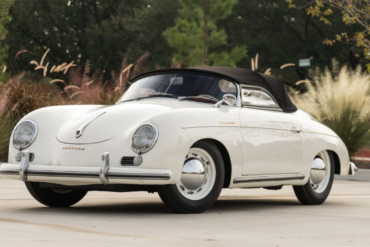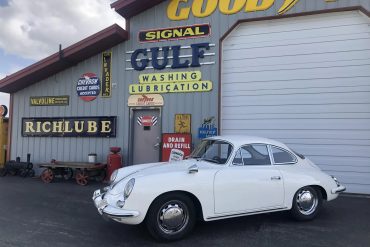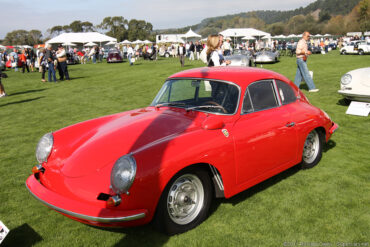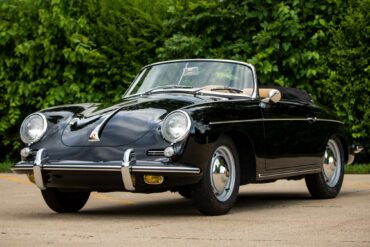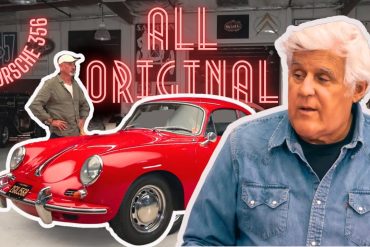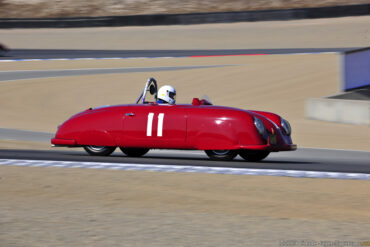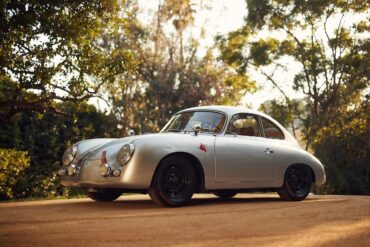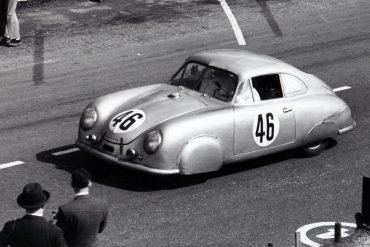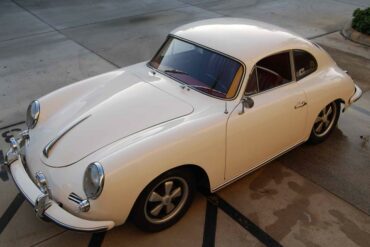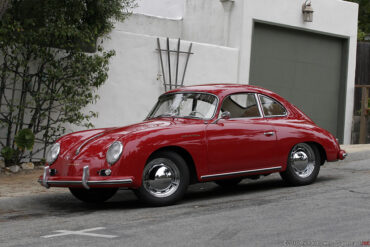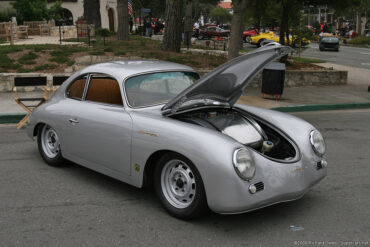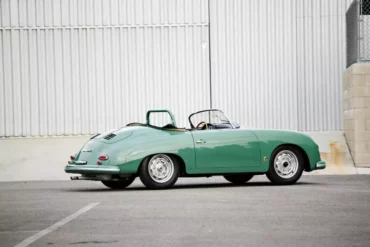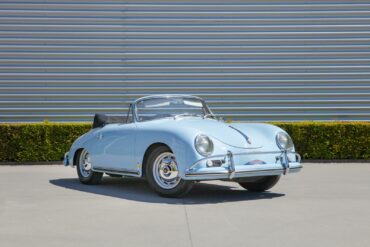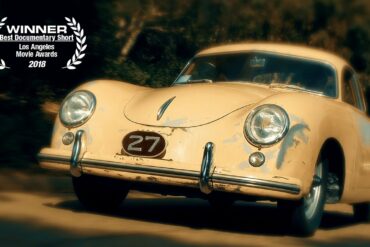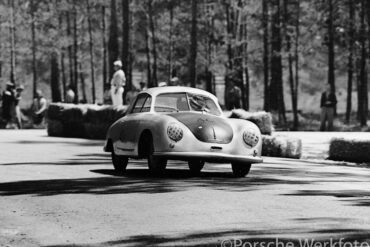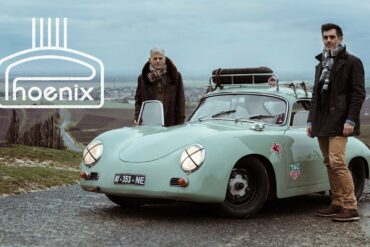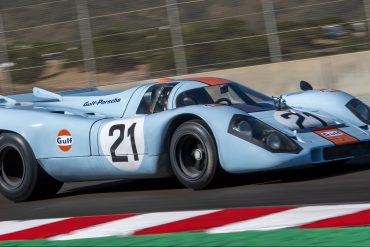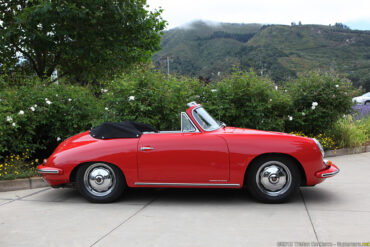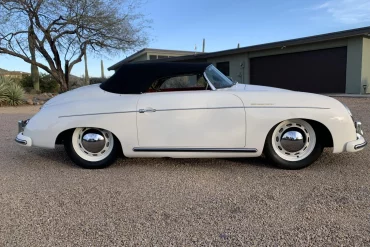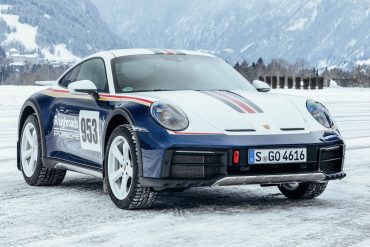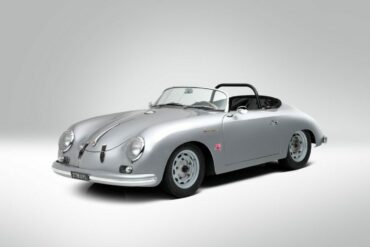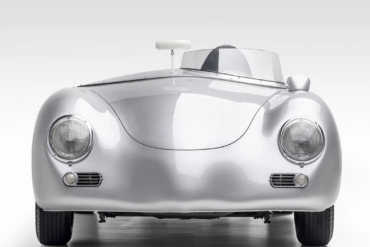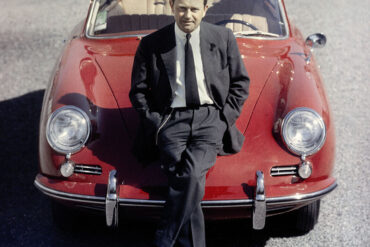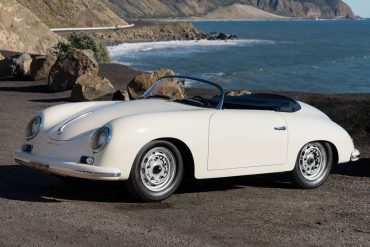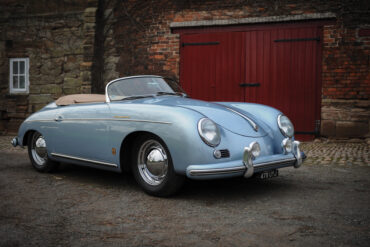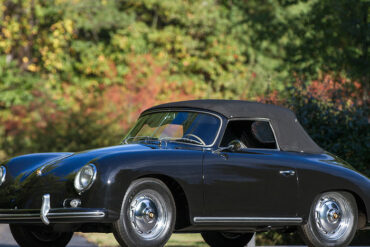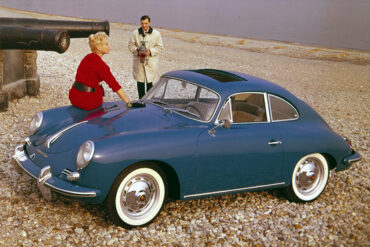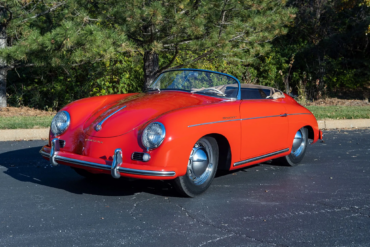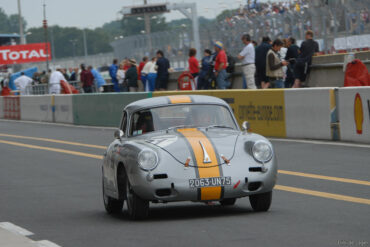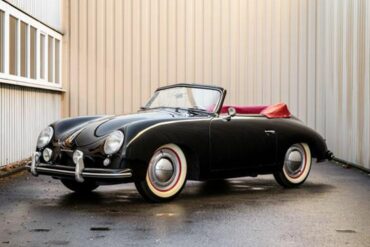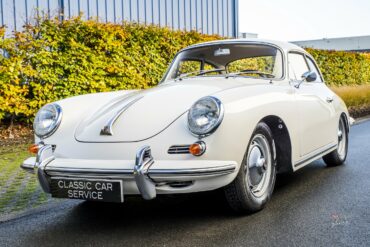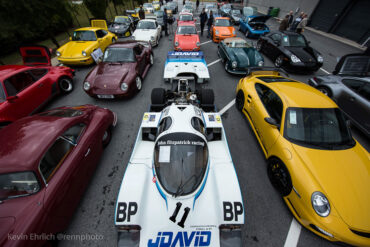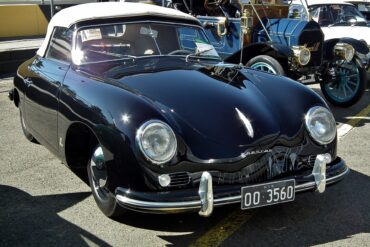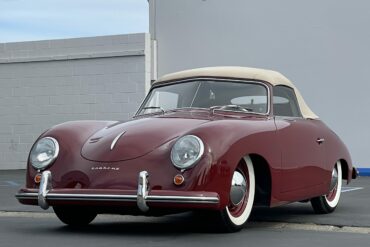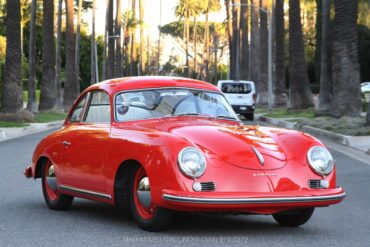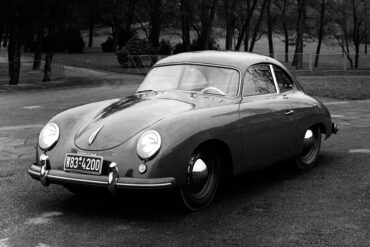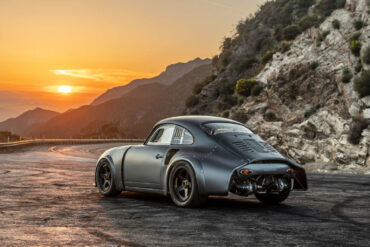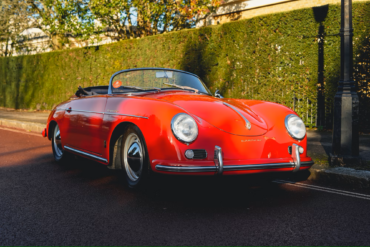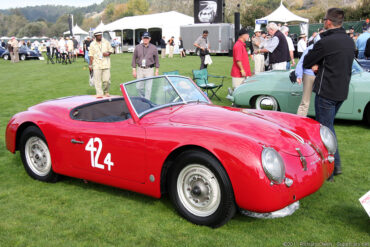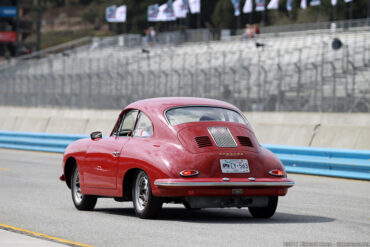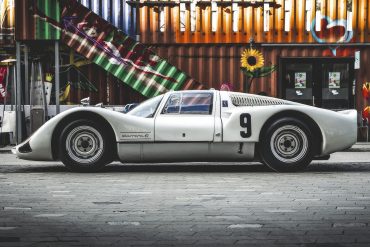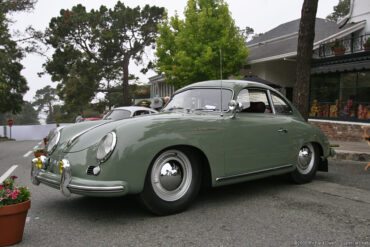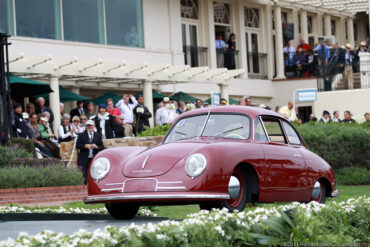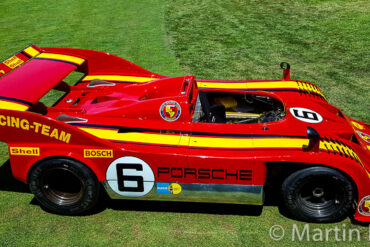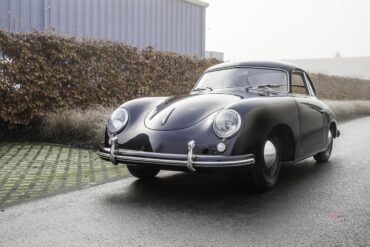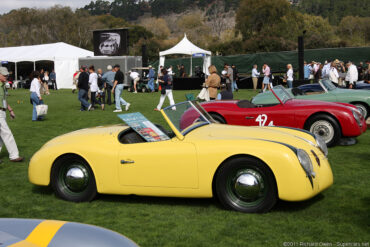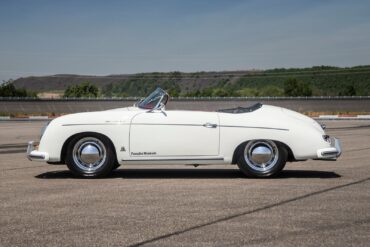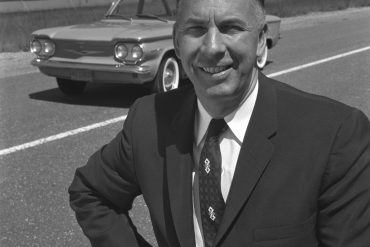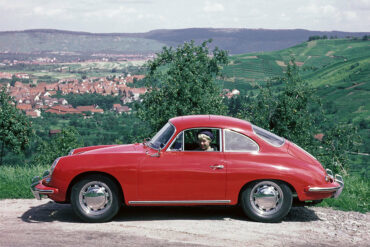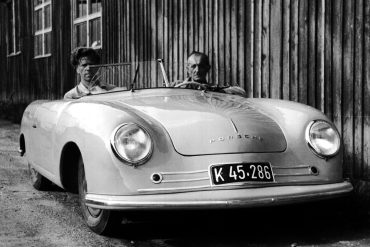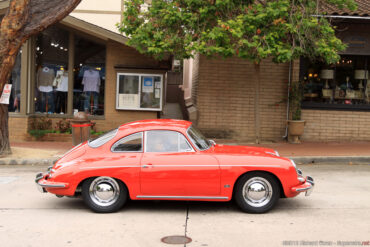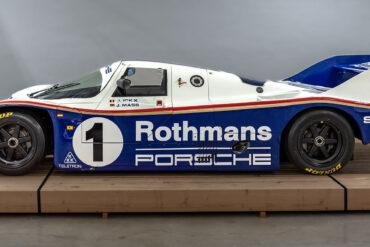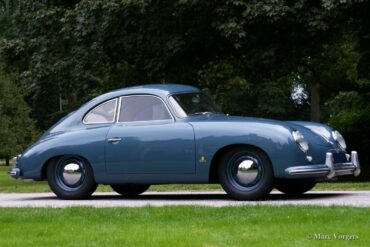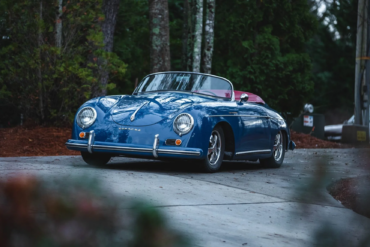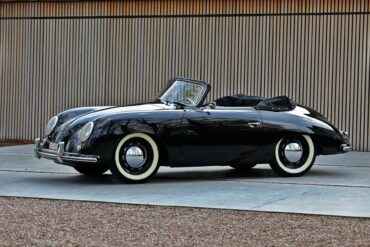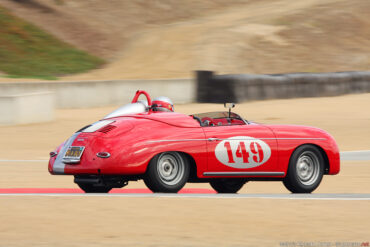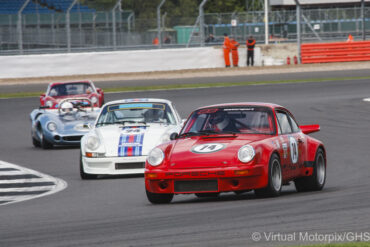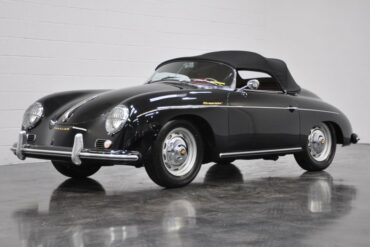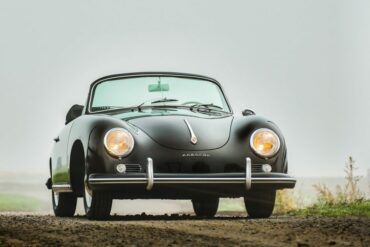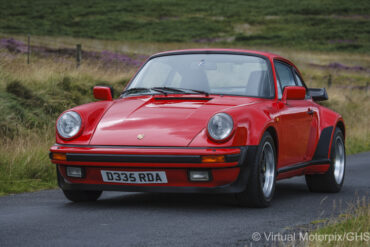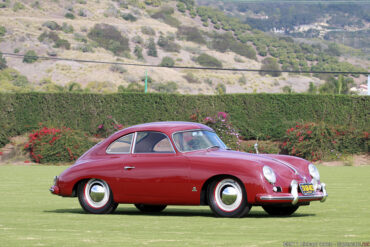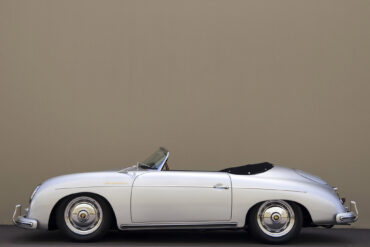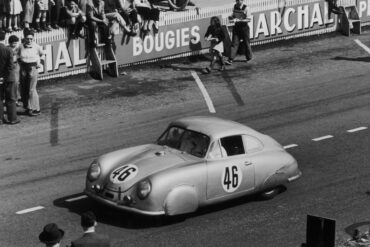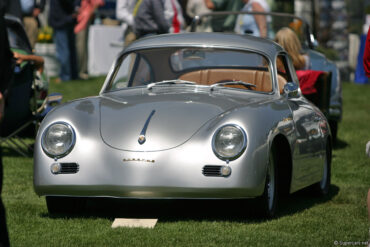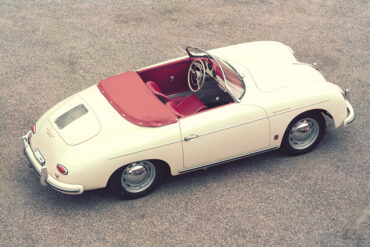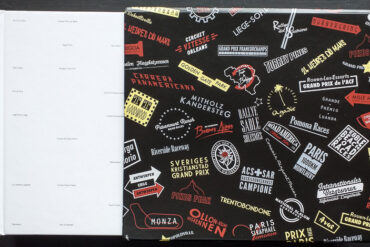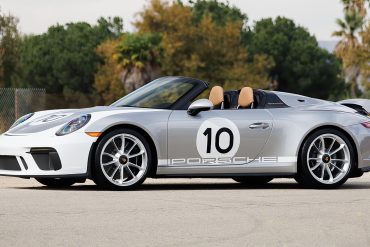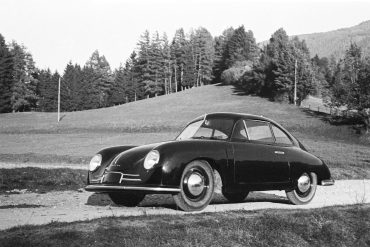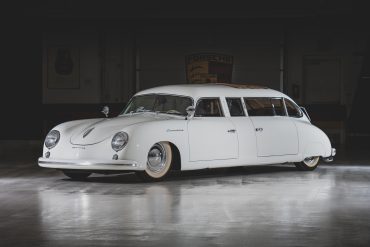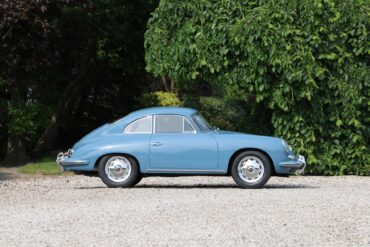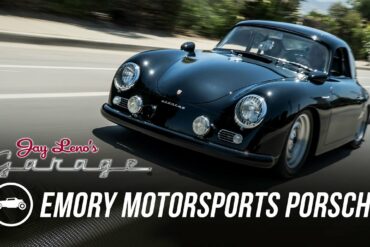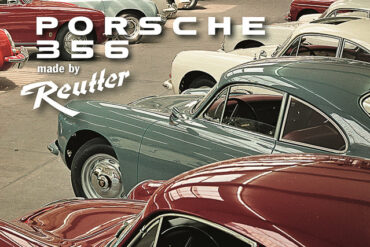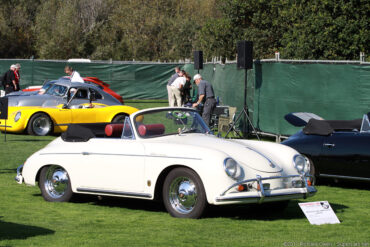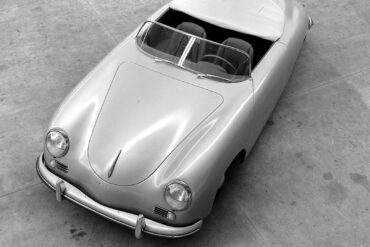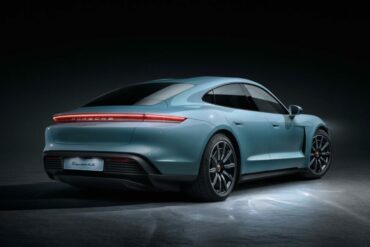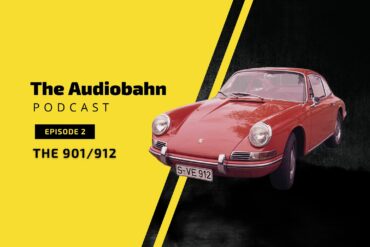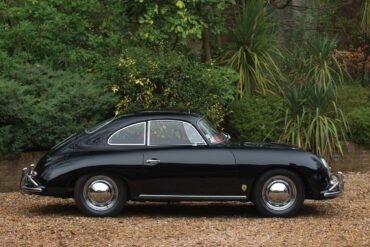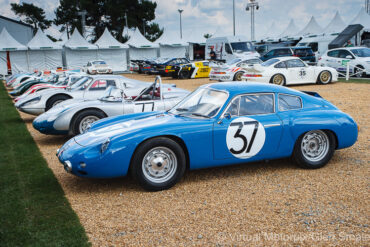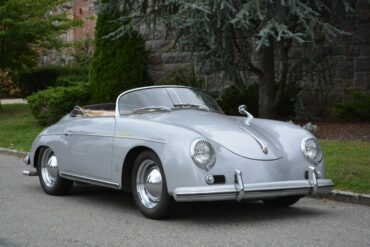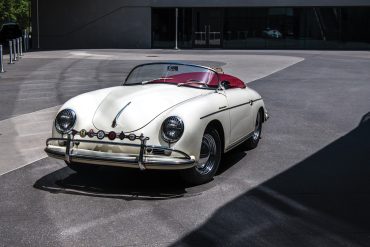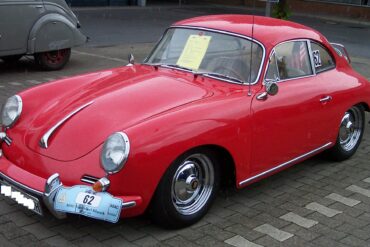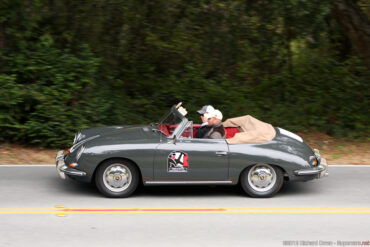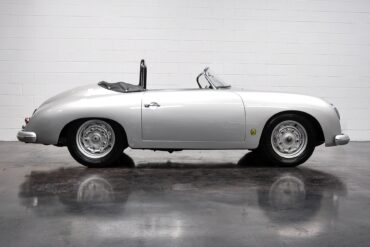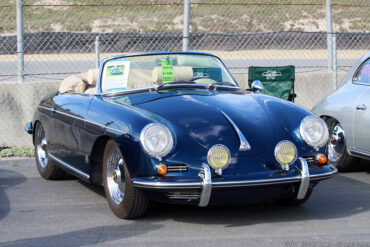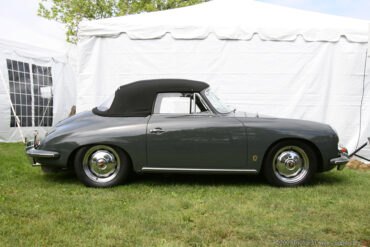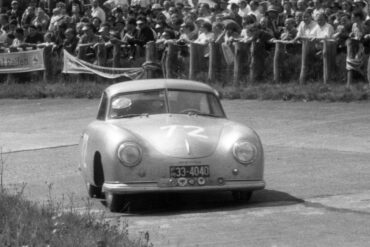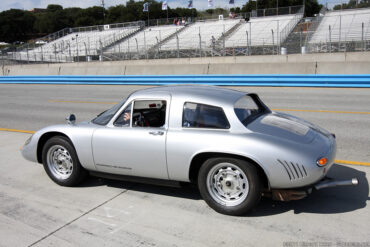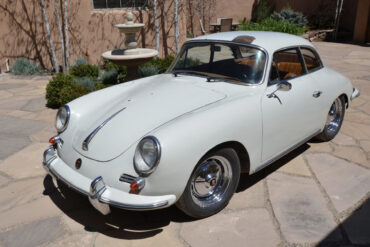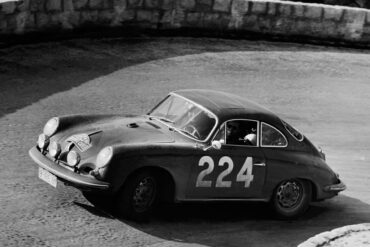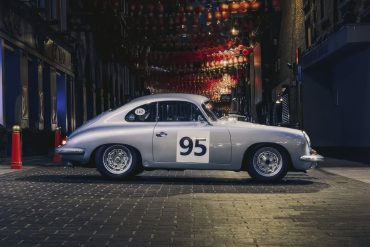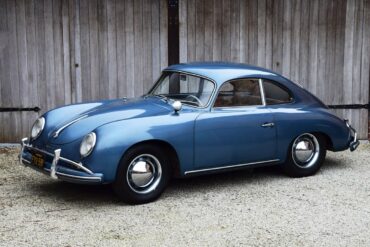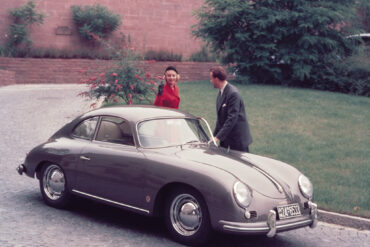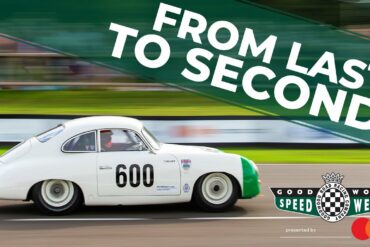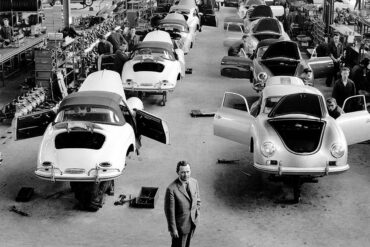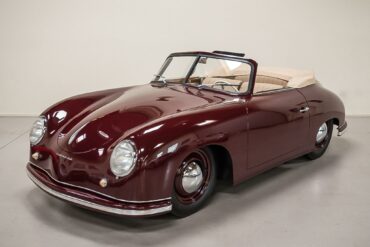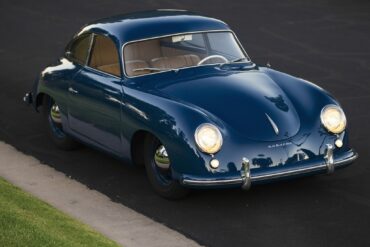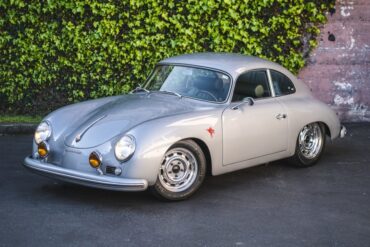Generally speaking the early models or so called ‘Pre A 356′ models are more desirable than the later models. At the top of the pyramid and the most exclusive is the Carrera version which carries the legendary 4 cam ‘Fuhrman’ engine. But just below that comes the ‘Super’ speedster. The ‘super’ version had more horsepower (75 vs the standard 60) and the powerful ‘type 528 engine’ for the 1500 Super version.
Porsche 356
The Porsche 356 was the first production car from Porsche. Earlier cars designed by the company included Cisitalia Grand Prix race car, the Volkswagen Beetle, and Auto Union Grand Prix cars, but it was the 356 that changed things forever for sports car enthusiasts the world over. Ferdinand Porsche, Sr. founded the company that still bears his name, but it was his son Ferdinand, widely known as Ferry, who created the Porsche we know today. In the early years after WWII, the 356 was the car that made Porsche famous. See our Porsche 356 Research Hub
Bring A Trailer is offering two beautiful Porsche examples, a 2016 Porsche Cayman GT4 and a 1964 Porsche 356C Coupe....
1960 – 1961 Porsche 356B/1600 Super 90 GT Coupe Pictures & Gallery...
In September of 1959 Porsche revealed their fully updated 356 known as the 356B. This had a completely revised body that was more suitable for the American market. The 1600 Super was also known as the 1600 S and that is what we are covering on this page. The 1600 Super sat in the middle of the lineup, below the Super 90 and above the base 1600. There were several variants with the base 1600 S engine, including the Coupe, Cabriolet, Notchback Coupe and Roadster, across both the T5 generation and T6 generation.
Porsche is most renowned for the 911, but it was the 356 that first established the German brand’s reputation. In...
When Porsche went to Le Mans, they reverted to aluminum shells made at their first factory in Gmünd, Austria. Three of these coupes, called 356 SL, raced Le Mans. All three Le Mans cars were shipped to America by Max Hoffman and sold to Fritz Kosler, Ed Trego and John von Neumann for SCCA racing. Before the 1952 races at Torrey Pines, von Neumann had Emil Diedt remove the coupe's roof, creating in effect the first Carrera Speedster.
Emory Motorsports is a company that makes the best Porsche “Outlaw” cars. The attention to detail is stunning and there...
Invitation to race from Charles Faroux Charles Faroux was a car enthusiast, a racing official, a leading French motor-publication editor...
1959 – 1963 Porsche 356B/1600 S Coupe Pictures & Gallery...
1956 – 1959 Porsche 356A/1500GS Carrera Coupe Pictures & Gallery...
1957 – 1958 Porsche 356A/1500GS Carrera GT Coupé Pictures & Gallery...
1957 – 1958 Porsche 356A/1500GS Carrera GT Speedster Pictures & Gallery...
1956 – 1957 Porsche 356A/1300 Cabriolet Technical Specifications WHAT BODY STYLE? 2 door fixed-head coupé with 2+2 seats HOW LONG?...
1953 Porsche 356 America After decades collecting dust in a storage building in the California desert, a 1953 Porsche 356...
Porsche 356 SL bodies lined up in the Reutter workshop (Werk 2) in 1951. This facility was used as the...
The Auratium Green 356 A Type 2 Please turn on Closed Captions to enjoy this film in English. This is...
Having just experienced the seventh Rennsport Reunion at Weathertech Raceway, Laguna Seca, it’s clear absolutely nothing would get in the...
1962 – 1963 Porsche 356B/2000GS Carrera 2 Pictures & Gallery...
There are two interesting Porsches on offer at Bring a Trailer today: a 1955 Porsche 356 1500S Speedster coming from...
Before we submerse ourselves in a new year of challenges and innovations, we take a look back on out top...
Despite looking outwardly similar to the preceding models, Porsche thoroughly updated their 356 line in 1956 and called their new model the 356A. At the core, this included a larger 1600 cc engine, but also a curved-glass windshield and a thoroughly revised suspension. At the 1955 Frankfurt Motor Show in September of 1955, Porsche released the 356A/1600 to the world with cabriolet, coupe and speedster bodies from Reutter. The 356A/1600 was a great performer, good for a sprint to 60 mph in 13.5 seconds and hit a top speed of 109 mph.
It’s really hard not to love this Porsche 356 A Carrera Speedster! Photo Credit: Ted7 (@iamted7)...
The Porsche 356 Story Porsche engineering company had designed cars for other companies for a long time, but it was...
Carrera Speedster In 1955, less than a year after the 356 Speedster model was introduced, Porsche built the first example...
1954 – 1955 Porsche 356/1500 Speedster Pictures & Gallery...
1956 – 1959 Porsche 356A/1600 Super Cabriolet Technical Specifications Model Year 1956 – 1959 Built At Stuttgart, Germany Body Stylist...
The 356 B T5 Coupe was the direct replacement of the Porsche 356 A Coupe. The T5 Coupe bodies were produced by German coachbuilder company Reutter. The 356 B T5 Coupe played a huge role in the growth seen by Porsche in the early 1960s. Like the Cabriolet, Roadster, and Notchback Coupe siblings, the Coupe was offered with 1600, 1600S, S90, and Carrera engine options paired to a four-speed synchromesh 741 transmission. In late 1961, Porsche introduced the T6 body and updates, which built on the success of its very popular predecessor.
Bring A Trailer is currently offering a 1955 Porsche 356 Pre-A Speedster equipped with a 1,500cc air-cooled flat-four engine. In...
1959 – 1963 Porsche 356B/1600 Coupe Pictures & Gallery...
1953 – 1955 Porsche 356/1500 Super Cabriolet (Pre-A) Technical Specifications Type Series Production Car Production Years 1953 – 1955 Built...
1961 – 1963 Porsche 356B/1600 Notchback Coupe Technical Specifications Type Series Production Car Production Years 1961 – 1963 Built At...
Lot 200 – 1983 Porsche 956-110 awaits its turn on the auction block The mental wheels started turning when RM...
In 1953, the 1300 S or "Super" was introduced, and the 1,100 cc engine was dropped. The 360 1300 Super boasts a power improvement to 60 BHP with Porsche's "Super" engine in the Porsche 356 model range. Minor visual differences were implemented such as front indicators integrated with the horn grilles and bumpers protrude from the body with over-riders. In June 1954, the plain-bearing 1300cc engine switched over to the same block as the 4cc larger roller-bearing variant.
1956 – 1957 Porsche 356A/1300 Cabriolet Pictures & Gallery...
1954 – 1955 Porsche 356/1300 Split-Window Coupe (Pre-A) Technical Specifications Type Series Production Car Production Years 1954 – 1955 Built...
The 1500 was Porsche’s newest engine which was quickly fitted with 40 PIBC Solex carburetors to produce 60 bhp @ 5000 rpm in 1952. These retained the Hirth roller-bearing crankshafts which gave Porsche enough clearance to enlarge their engine to 1500cc. Most cars from 1952 until the 356A of 1956 were powered by the 1500 engine but some left the factory with the smaller 1.1 and 1.3-liter engines. At the request of American importer Max Hoffman, 356s for the 1955 model year were badged as Continentals before reaching the U.S
Want to Join the Outlaw Gang? Rod Emory makes some of the most insane modified Porsches out there. This Porsche...
Collecting Cars is currently offering a 1957 Porsche 356 A Speedster that was purchased and owned for 50 years by...
1952 Porsche 356 ‘America Roadster’ Pictures & Gallery...
1962 – 1963 Porsche 356B/2000GS Carrera GT Pictures & Gallery ...
Background In the Porsche world, “Luftgekühlt” represents all the air-cooled cars in the manufacturer’s history, from the Pre-A 356 through...
1955 Porsche 356/1500 Continental Coupe (Pre-A) Technical Specifications Type Series Production Car Built At Stuttgart, Germany Body Stylist Erwin Komenda...
Porsche 356/2 Gmünd Coupé Specifications type Series Production Car production years 1948 – 1951 built at Austria production 41 price...
In a year where Porsche is launching more cars than ever before, the largest gathering of car enthusiasts, art connoisseurs,...
Plenty of 911-based cars were entered in the Concours The Hillsborough (California) Concours d’ Elegance, on 21 July 2019, has...
1952 – 1954 Porsche 356/1100 Coupe (Pre-A) Pictures & Gallery...
This isn't technically a Speedster, but the Type 540 (Typ 540 K/9-1 to be very precise) - known more commonly as the America Roadster - started the idea. The American Roadster was the direct predecessor of the Speedster. U.S. importer Max Hoffman convinced Porsche it needed a lightweight convertible to compete. It only had an emergency folding roof and could keep up with larger sports cars of the era. But the production methods used to create the America Roadster’s aluminum body proved to be too expensive, and in 1952 Porsche built only 21 units before its discontinuation in 1953.
Porsche 356 Production & Chassis Numbers (1950 – 1965) The evolution of the 356 was constant throughout its production history....
People usually recall the Chevrolet Corvair as the car that was “unsafe at any speed” which is rather unfair because...
Introduced in 1963 for the 1964 model year, the base model Porsche 356 1600C Coupe was presented as the entry-level version of the last generation of the Porsche 356 Coupes. After offering standard/base model versions for the 356 A and 356 B with 60 HP engines, Porsche dropped the standard version as its base model and introduced the successor of the former mid-level 1600 Super engine variant with 75 HP, as the entry-level engine option for the 356 C generation. As with previous generations, it was also offered with the 356 C Cabriolet cars.
Sorry, but you do not have permission to view this content....
1964 Porsche 356C/2000GS Carrera 2 Pictures & Gallery...
Porsche & Le Mans Newly released “Racing with Giants” video features archival footage of Le Mans past and present, along...
Towards the end of 1951 Porsche introduced a larger version of the flat four engine. It was offered alongside the original 1.1 litre engine. It took a lot more effort to develop the third variation on the four cylinder theme; the '1500.' Introduced in the 356 1500 during 1952, the engine produced 55 bhp. Porsche's competition department reworked the 1500 engine with hotter cams and bigger Carburetors, boosting power to 70 bhp. In 1952 this engine found its way into a new road car; the 356 Super.
Live now on Bring A Trailer is fantastic example of a 1955 Porsche 356 Speedster finished in Oslo Blue over...
1953 – 1955 Porsche 356/1500 Super Cabriolet (Pre-A) Pictures & Gallery...
1959 Porsche 356A/1600 Convertible D Pictures & Gallery...
1956 – 1959 Porsche 356A/1600 Cabriolet Technical Specifications Production Years 1956 – 1958 Released At 1955 Frankfurt Motor Show Built...
An Automotive Icon One of the most iconic Porsches of all time is the 356A Cabriolet and now you have...
Celebrations for the #55 Porsche 550 Spyder after finishing third in the 1954 La Carrera Panamericana. Sitting on the #55...
1952 – 1955 Porsche 356/1500 Coupe (Pre-A) Pictures & Gallery...
1956 – 1958 Porsche 356A/1600 Speedster Pictures & Gallery ...
In 1950, eleven remaining Gmund chassis were assembled after the factory returned to Germany and converted to SL (Sport Leicht) racing specification. They received 1,086-cc engines, enlarged fuel tanks, louvered quarter-window covers, wheel spats, streamlined aluminum belly fairings, and a pedestal-mounted shifter. Three Type 356/2 cars raced at Le Mans in 1951; two crashed, but 356/2-063 performed flawlessly, winning the 1,100-cc class.
Following the Pre-A prototypes and a run of quad-cams with the 1500cc engine, the 1600 Carrera GT was a performance 356 that used a larger version of the Porsche 550 Spyder's potent engine. As early as 1958, some Carreras were fitted with a larger engine known as the Type 692. The new unit featured a larger displacement which was better suited for the 1600cc class. Furthermore, it was improved considerably adopting plain bearings and new ignition system.
1956 – 1958 Porsche 356A/1600 Speedster Technical Specifications Production Years 1956 – 1958 Released At 1955 Frankfurt Motor Show Built...
SportErfolge: by Tony Adriaensens – page photographs by © Virtual Motorpix/Glen Smale Simply titled, SportErfolge (English: Success in Sport), this...
The original light-weight The Speedster variant of the 356 was introduced in 1954, featuring a low-raked windscreen, bucket seats, and...
With lessons learned from 356 No. 1, Porsche developed the 356/2 as a production-ready version. The biggest concession to useability was repositioning the engine back behind the rear wheels as the original VW design. Like 356 No. 1, 356/2 was built as two-seat roadster using VW parts.
The man behind this 356 limousine is John Dixon who decided to create a personalized Porsche-based limousine for his daughter’s...
1956 – 1957 Porsche 356A/1300 Super Coupe Pictures & Gallery...
A Drive In An Emory Outlaw 356 Third generation SoCal gearhead Rod Emory takes Jay through his 1958 Emory Special...
Porsche 356 – Made by Reutter: by Frank Jung © Delius Klasing Verlag When the second edition of this fine...
1956 – 1959 Porsche 356A/1500GS Carrera Cabriolet Pictures & Gallery...
Let’s face it, the Porsche 911 was the most successful model produced by Porsche in the 20th century, and it...
One of the Best ‘Outlaws’ on the Planet Emory Motorsports is a company that makes the best Porsche “Outlaw” cars....
Episode Two: The Porsche 901/912 Summary Welcome to The Audiobahn, the Stuttcars.com podcast focused on all things Porsche. In our first...
1956 – 1959 Porsche 356A/1600 Super Coupe Pictures & Gallery ...
Porsche 356 Carrera GTL Abarth on 05/07/2018 at the Le Mans Classic, 2018 Although the temperatures have hovered around the...
1956 – 1958 Porsche 356A/1600 Super Speedster Technical Specifications Model Year 1956 – 1958 Built At Stuttgart, Germany Body Stylist...
If you were lucky enough to visit Rennsport Reunion 7 in Monterey, California, then chances are you gazed at one...
Designed by Ferry Porsche, the 356 was based on the Volkswagen created by his father, Ferdinand Porsche. Like the ‘Beetle’,...
Going Global Luftgekühlt – the hit Californian-born gathering of air-cooled Porsches – lay down new roots in Europe in mid-June,...
1956 – 1959 Porsche 356A/1600 Super Coupe Technical Specifications Model Year 1956 – 1959 Built At Stuttgart, Germany Body Stylist...
1964 – 1965 Porsche 356 C 1600C Cabriolet Pictures & Gallery...
1956 – 1958 Porsche 356A/1500GS Carrera Speedster Technical Specifications Type Series Production Car Built At Germany Coachbuilder Reutter Karosserie Price...
1959 – 1963 Porsche 356B/1600 Roadster Gallery Porsche 356 B 1600 Roadster (T5) – Pictures & Gallery Porsche 356 B...
1962 – 1963 Porsche 356B/2000GS Carrera 2 Cabriolet Technical Specifications Type Series Production Car Built At Germany Engine Type 548...
Sorry, but you do not have permission to view this content....
1963 Porsche 356B/2000GS Carrera 2 GT Dreikantschaber Pictures & Gallery...
1961 – 1963 Porsche 356B/1600 Super 90 Notchback Coupe Pictures & Gallery...
Amongst Porsche 356 enthusiasts, perhaps no model is more coveted than a C-Series Carrera 2. The Carrera 2 represents the culmination of Porsche’s racing technology fitted into a road car package and the ultimate performance-first sports car in the 356 model lineup. The 1,966-cubic centimeter, mechanically complex four-cam Type 587/1 engine was the most powerful unit that Porsche had ever created for a production car, developing 130 brake horsepower at 6,200 rpm.
This 356B Carrera GT is a superb representative of the early Carrera legend and the sole known survivor of only...
1956 – 1957 Porsche 356A/1300 Super Coupe Technical Specifications WHAT BODY STYLE? 2 door fixed-head coupé with 2+2 seats HOW...
Despite looking outwardly similar to the preceding models, Porsche thoroughly updated their 356 line in 1956 and called their new model the 356A. At the core, this included a larger 1600 cc engine, but also a curved-glass windshield and a thoroughly revised suspension. At the 1955 Frankfurt Motor Show in September of 1955, Porsche released the 356A/1600 to the world with cabriolet, coupe and speedster bodies from Reutter. Produced in 1959 only, the Porsche 356 Convertible D was the replacement for the 356 A Speedster, which was discontinued after 1958.
8 minutes of Porsche 356 goodness British Touring Car runner-up Sam Tordoff had quite the time in the Fordwater Trophy...
The world of early Porsche production This footage was taken between late 1959 and late 1961. Great view into the...
1950 – 1951 Porsche 356/1100 Split-Window Cabriolet (Pre-A) Technical Specifications Type Series Production Car Production Years 1950 – 1951 Built...
Porsche 356 Engine Codes There are several important numbers to identify a 356 engine. The first, and most obvious one,...
From the outside, the 356A kept to the Porsche mantra of stepwise evolution. The new model was outwardly identical to the previous version except for the wider tires, a small rub-strip below the doors, a fully-curved front window and enamel paint replacing lacquer previously used. The 356 A came with an all-alloy air-cooled Flat 4 engine in four states of tune, with the 1300 having Type 506/2 engine with 44 bhp and 60 lb-ft.


